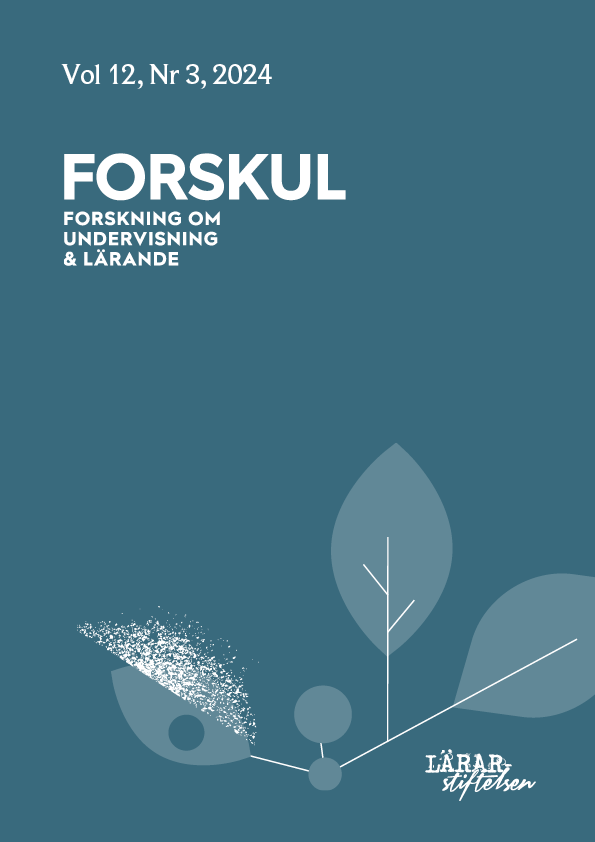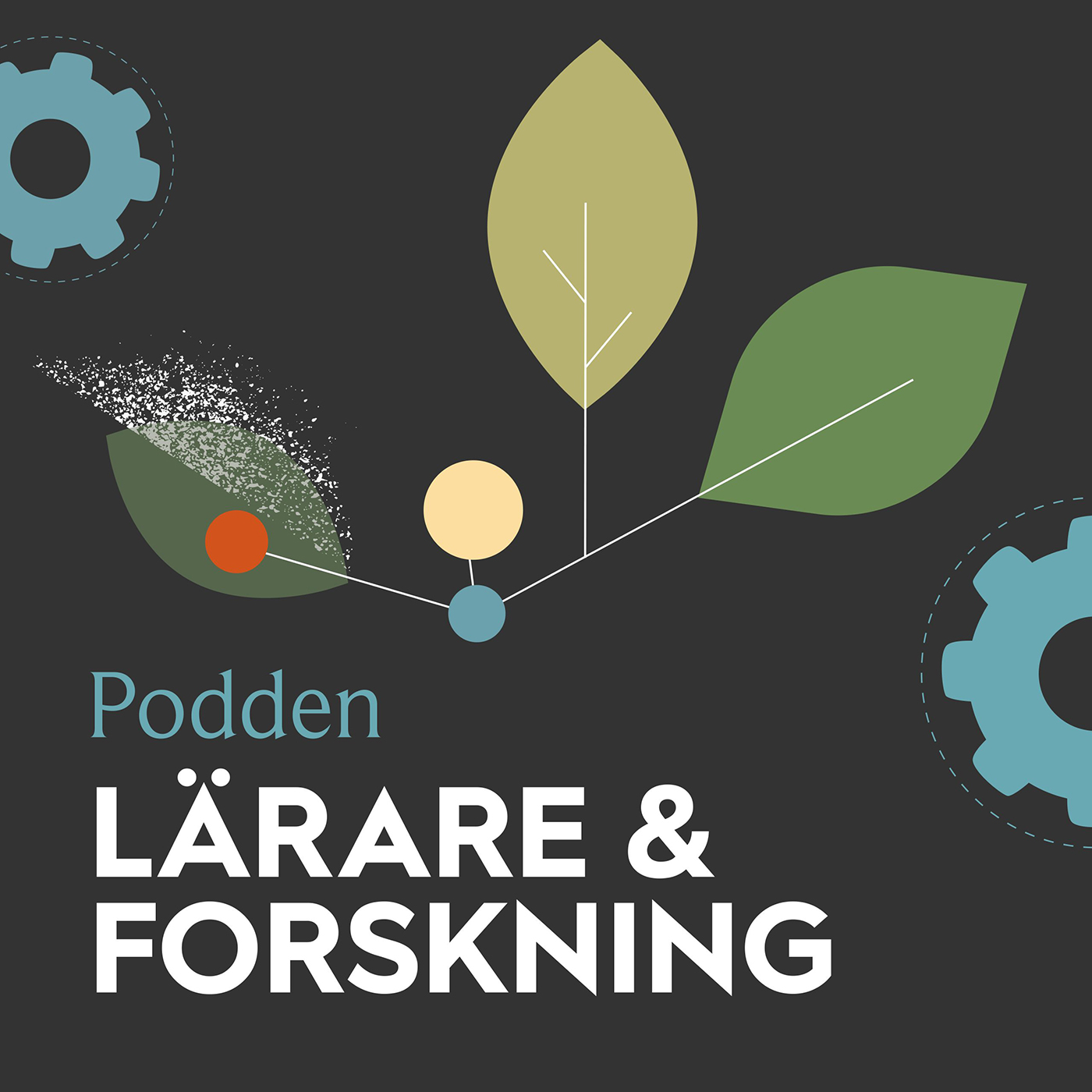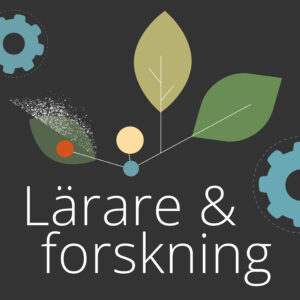Lärares möjligheter att främja elevers teoretiska arbete med geometriska begrepp – lärandeverksamhet om cirkel
DOI:
https://doi.org/10.61998/forskul.v12i3.26653Nyckelord:
cirkel, El’konin-Davydov program, geometriska begrepp, lärandeverksamhet, undervisningsdesignAbstract
I följande artikel diskuteras vad som karaktäriserar lärares handlingar som främjar elevers engagemang, i en lärandeverksamhet där de tillsammans med sina klasskamrater utforskar de geometriska begrepp som relaterar till begreppet cirkel. Data består av tre forskningslektioner i årskurs 2 där lärandeobjektet handlar om att reflektera över relationer mellan cirkelns fyra begrepp; mittpunkt, radie, diameter och cirkelbåge. Resultatet visar att lärares handlingar som fokuserade på de geometriska begreppen riktades mot både empiriska och teoretiska aspekter. Indikationer på utveckling av lärandeverksamhet kunde urskiljas i situationer där läraren introducerade, kopplade tillbaka, bekräftade, provocerade, inkluderade och fördjupade detaljer om begreppen som relaterar till cirkel. Med stöd av lärarhandlingar, som bestod av frågor, gester och konstruktioner på den gemensamma tavlan, möjliggjordes elevernas utforskande av begreppet cirkel.
Teachers’ opportunities to promote students’ theoretical work with geometric concepts – a learning activity about circle
The following article discusses what characterise teachers‘ actions that promote students’ engagement, in a learning activity where they, together with their classmates, explore the geometric concepts related to the concept of circle. The data consists of three research lessons in grade 2 where the learning object is about reflecting on relationships between the four concepts of the circle: centre, radius, diameter and arc. The result shows that teachers' actions focusing the geometric concepts were directed towards both empirical and theoretical aspects. Indications of developing learning activity were discerned in situations where the teacher introduced, connected back, confirmed, provoked, included and deepened details about the concepts that relate to circle. Supported by teacher actions, consisting of questions, gestures and constructions on the joint board, students' exploration of the concept of circle was enabled.
Referenser
Adolfsson Boman, M., Eriksson, I., Hverven, M., Jansson, A. & Tambour, T. (2013). Att introducera likhetstecken i ett algebraiskt sammanhang för elever i årskurs 1. Forskning om undervisning och lärande, (10), 29–49. https://doi.org/10.61998/forskul.v1i10.27607 DOI: https://doi.org/10.61998/forskul.v1i10.27607
Arievitch, I. & Haenen, J. (2005). Connecting sociocultural theory and educational practice: Galperin's approach. Educational Psychologist, 40(3), 155–165. https://doi.org/10.1207/s15326985ep4003_2 DOI: https://doi.org/10.1207/s15326985ep4003_2
Björk, M. (2023). Att främja elevers teoretiska utforskande av bassystemet – en undervisningsutvecklande studie i matematik på mellanstadiet. [Licentiatuppsats, Stockholms universitet]. https://urn.kb.se/resolve?urn=urn%3Anbn%3Ase%3Asu%3Adiva-214255
Broman, A., Waermö, M. & Chudinova, E. (2022). The modelling in developmental education: A condition for theoretical abstraction and generalization. Revista Educativa – Revista de Educação, 25(1), 1–25. https://doi.org/10.18224/educ.v25i1.12762 DOI: https://doi.org/10.18224/educ.v25i1.12762
Carlgren, I. (2017). Undervisningsutvecklande forskning – exemplet Lerning study. Gleerups.
Davis, B. (1997). Listening for difference: An evolving conception of mathematics teaching. Journal for Research in Mathematics Education, 28(3), 355–376. https://doi.org/10.2307/749785 DOI: https://doi.org/10.5951/jresematheduc.28.3.0355
Davydov, V. V. (1990). Types of generalization in instruction: Logical and psychological problems in the structuring of school curricula (J. Teller, Övers.). National Council of Teachers of Mathematics.
Davydov, V. V. (2008). Problems of developmental instruction. A theoretical and experimental psychological study (2 uppl.). Nova Science Publishers.
Eriksson, H. (2021). Att utveckla algebraiskt tänkande genom lärandeverksamhet: En undervisningsutvecklande studie i flerspråkiga klasser i grundskolans tidigaste årskurser. [Doktorsavhandling, Stockholms universitet]. http://su.diva-portal.org/smash/record.jsf?pid=diva2%3A1529155&dswid=-2891
Eriksson, I. (2017). Lärandeverksamhet som redskap i en learning study. I I. Carlgren (Red.), Undervisningsutvecklande forskning – exemplet Learning study (s. 61–85). Gleerups.
Eriksson, I. & Jansson, A. (2017). Designing algebraic tasks for 7-year-old students – a pilot project inspired by Davydov's learning activity. International Journal for Mathematics Teaching and Learning, 18(2), 257–272. https://doi.org/10.4256/ijmtl.v18i2.67 DOI: https://doi.org/10.4256/ijmtl.v18i2.67
Eriksson, I. & Polotskaia, E. (2017). Editorial. International Journal for Mathematics Teaching and Learning, 18(2), 132–135. DOI: https://doi.org/10.4256/ijmtl.v18i2.106
Fred, J. (2019). Att etablera och upprätthålla ett algebraiskt arbete i årskurs 2 och 3: En undervisningsutvecklande studie med matematiska mönster som innehåll. [Licentiatuppsats, Stockholms universitet]. https://urn.kb.se/resolve?urn=urn:nbn:se:su:diva-176382
Hintz, A. & Tyson, K. (2015). Complex listening: Supporting students to listen as mathematical sense makers. Mathematical Thinking and Learning, 17(4), 296–326. https://doi.org/10.1080/10986065.2015.1084850 DOI: https://doi.org/10.1080/10986065.2015.1084850
Jones, K., Maschietto, M., Doze, J. & Papadaki, C. (2019). Introduction to the papers of TWG04: Geometry teaching and learning. Eleventh Congress of the European Society for Research in Mathematics education. Utrecht University, Erme.
Kilhamn, C. & Säljö, R. (2019). Encountering algebra. A comparative study of classrooms in Finland, Norway, Sweden, and the USA. Springer. https://doi.org/10.1007/978-3-030-17577-1_4 DOI: https://doi.org/10.1007/978-3-030-17577-1
Kiselman, C. & Mouwitz, L. (2008). Matematiktermer för skolan. Nationellt Centrum för Matematik.
Liljedahl, P. (2022). Att bygga tänkande klassrum i matematik. Gleerups.
Lim, W., Lee, J., Tyson, K., Kim, H. & Kim, J. (2020). An integral part of facilitating mathematical discussions: Follow-up questioning. International Journal of Science and Mathematics Education, 18(2), 377–398. https://doi.org/10.1007/s10763-019-09966-3 DOI: https://doi.org/10.1007/s10763-019-09966-3
Mergenthaler, E. & Stinson, C. (1992). Psychotherapy transcription standards. Psychotherapy Research, 2(2), 125–142. https://doi.org/10.1080/10503309212331332904 DOI: https://doi.org/10.1080/10503309212331332904
Moore, R. (1994). Making the transition to formal proof. Educational Studies in Mathematics, 27, 249–266. https://doi.org/10.1007/BF01273731 DOI: https://doi.org/10.1007/BF01273731
Moxhay, P. (2008). Assessing the scientific concept of number in primary school children. International Society for Cultural-historical Activity Research (s. 1–24). San Diego: ISCAR.
Radford, L. & Roth, W.-M. (2017). Alienation in mathematics education: a problem solving considered from neo-Vygotskian approaches. Educational Studies in Mathematics, 96(3), 367–380. https://doi.org/10.1007/s10649-017-9769-0 DOI: https://doi.org/10.1007/s10649-017-9769-0
Repkin, V. (2003). Developmental teaching and learning activity. Journal of Russian and East European Psychology, 41(5), 10–33. DOI: https://doi.org/10.2753/RPO1061-0405410510
Serin, H. (2018). Perspectives on the teaching of geometry: Teaching and learning methods. Journal of Education and Training, 5(1), 131–137. https://doi.org/10.1007/978-3-319-77476-3_10 DOI: https://doi.org/10.5296/jet.v5i1.12115
Sinclair, N., Bartollini Bussi, M., Villers, M., Jones, K., Kortenkamp, K., Leung, U. & Owens, K. (2016). Recent research on geometry education: an ICME-13 survey team report. ZDM. The International Journal on Mathematics Education, 48, 691–719. https://doi.org/10.1007/s11858-016-0796-6 DOI: https://doi.org/10.1007/s11858-016-0796-6
Van Hiele, P. M. (1986). Structure and insight. A theory of mathematics education. Academic Press.
Vetenskapsrådet. (2017). God forskningssed [elektronisk resurs].
Vygotsky, L. (1963). Learning and mental development at school age. I B. Simon & J. Simon (Red.), Educational Psychology in the U.S.S.R. (s. 21–34). Rutledge & Kegan Paul.
Vygotsky, L. (1978). Mind in society: The development of higher psychological process. Harvard University.
Yackel, E. & Cobb, P. (1996). Sociomathematical norms, argumentation, and autonomy in mathematics. Journal for Research in Mathematics Education, 27(4), 458–477. https://doi.org/10.2307/749877 DOI: https://doi.org/10.5951/jresematheduc.27.4.0458
Zuckerman, G. (2004). Development of reflection through learning activity. European Journal of Psychology of Education, XIX(1), 9–18. https://doi.org/10.1007/BF03173234 DOI: https://doi.org/10.1007/BF03173234
Zuckerman, G. (2007). Supporting children's initiative. Journal of Russian and East European Psychology, 45(3), 9–42. https://doi.org/10.2753/RPO1061-0405450301 DOI: https://doi.org/10.2753/RPO1061-0405450301
Publicerad
Referera så här
Licens
Copyright (c) 2024 Helena Eriksson, Marie Björk, Jenny Fred, Gunilla Pettersson Berggren

Det här verket är licensierat under en Creative Commons Erkännande 4.0 Internationell-licens.
Författare till innehåll publicerat i Forskul behåller upphovsrätten till sina verk. Artiklar publiceras under villkoren i en Creative Commons-licens CC BY, som tillåter användning, nedladdning, distribution, länkning till och reproduktion i vilket medium som helst, förutsatt att originalverket är korrekt citerat.






